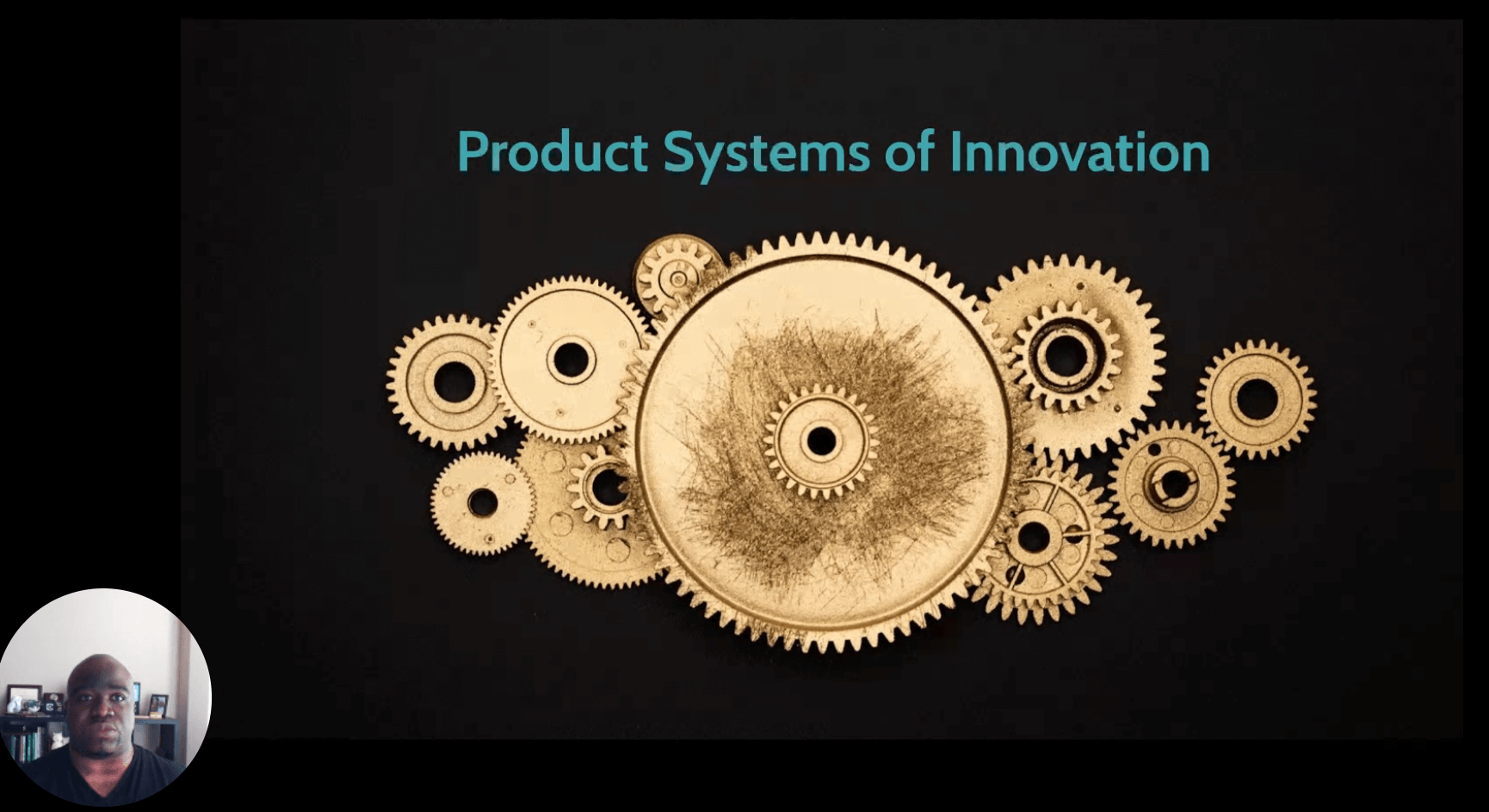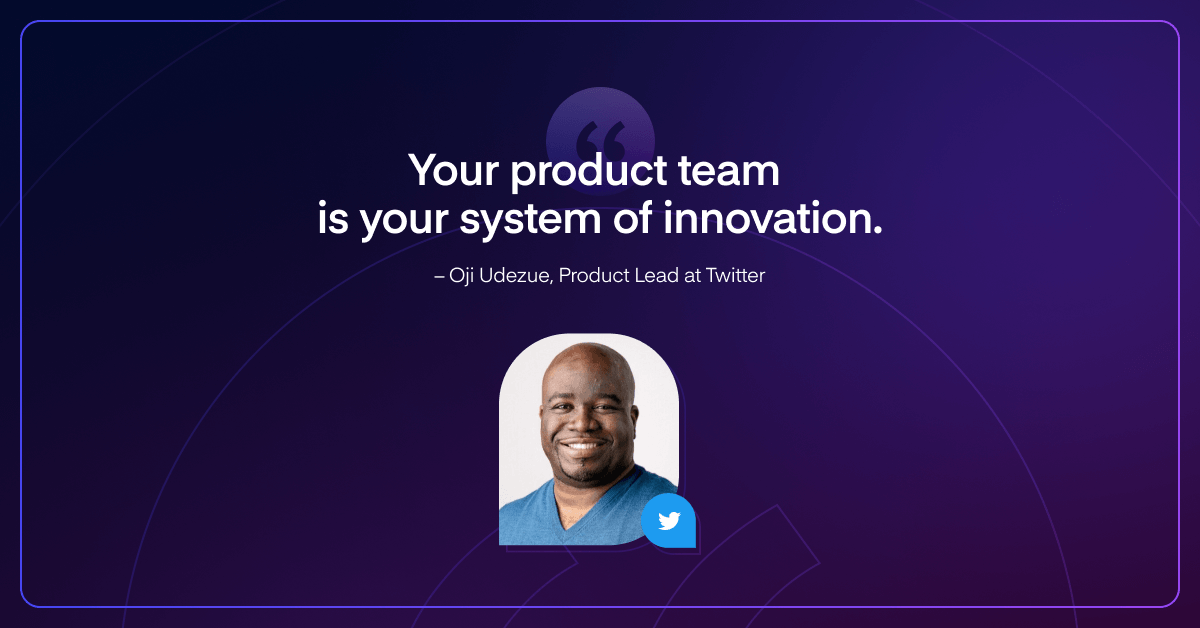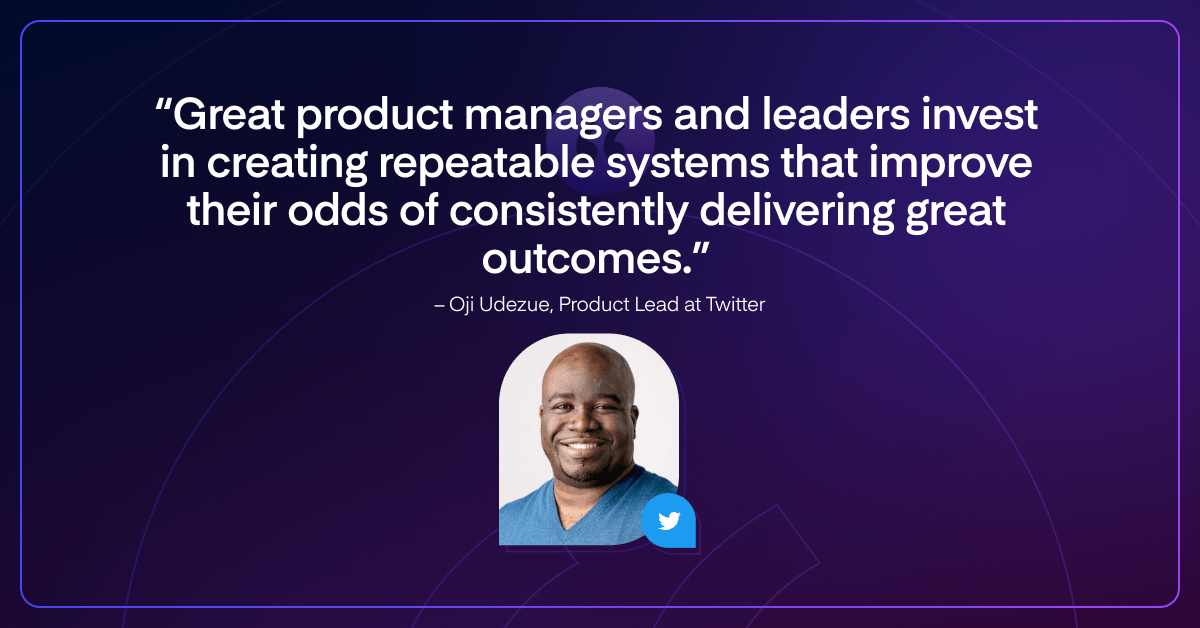How to Scale and Build High-Functioning Teams

Scrappy startup teams are glamorized throughout the business world, and with good reason. They’re “lean, mean, fighting forces,” and what Oji Udezwe, Product Lead for Twitter Creation and Conversations, says that all teams should strive to become.
As startups grow their customer base and scale their team, though, even the most dedicated, cohesive, and high-performing teams inevitably seem to lose the magic that propelled them to succeed in the first place.
Udezwe has seen it happen time and time again. He’s worked everywhere from early startups (including one that he founded, Intermingle) to major tech companies (like Calendly, Microsoft, and now Twitter). Over the course of his career, though, he’s been able to explore best practices that companies can enact in order to keep the “lightning in a bottle” from escaping, no matter how large their teams become.
Udezwe shared his insights at the 2021 Product Excellence Summit, noting that the key to keeping teams functioning optimally is to implement and embrace three types of product systems: systems of people, systems of direction-setting, and systems of execution.
Watch his full presentation here, or keep reading for a summary of Udezwe’s take on how establishing systems helps organizations take full advantage of the main “product” any company has — their team.
Product systems as the key to continued innovation
“A system is a planned, thoughtful approach to accomplishing your product goals through people. It’s an intentional combination of frameworks, process, and tools.”
The beauty of product systems lies in the fact that they’re not static. Product systems can and should be designed to have feedback loops that allow companies to refine their approach along the way to meet the company’s adapting needs and structure. “Give people in the organization the freedom to shape it, advance it, move it,” Udezwe says. Doing so ensures that systems continue to work for people, and not the other way around.
Udezwe wasn’t always the advocate for product systems that he is today. In fact, he used to be quite skeptical. “As an individual product manager, I sort of despised systems. I didn’t want any of that stuff getting in my way.”
After experiencing radical growth at many different companies, though, he began to see the benefits of using systems in order to scale product impact. Over time, Udezwe concluded that successfully scaling up requires well-functioning systems. The companies that create and understand product systems, he observed, are generally the ones that thrive.
“All of us know about the product systems at Spotify, at Gitlab, at Atlassian, what I tried to do at Calendly. It’s no accident, I’d guess, that the companies of lore in our industry have very strong product systems,” Udezwe said.

Three types of product systems
1. Systems of people
Creating “systems of people” is about designing the organization to get the most out of its talent.
When done correctly, Udezwe says, systems connect people’s skills and ambitions to the company objectives.
Product leaders will obviously focus much of their energies on product talent, but their role as “stewards of the ecosystem of innovation” means that they also have a vested interest in talent development throughout the organization.
“The most expensive and wonderful resource you have is people, so you should work overtime to keep them valued, motivated, inspired and productive,” Udezwe says.

Recognizing that nobody works in a vacuum, Udezwe himself makes sure to work with counterparts around the company to make sure that their approaches are aligned and in sync. While acknowledging that the resulting “people systems” across companies can and should look different, he offers a few elements to always keep in mind when developing them:
Design the way that people are organized in a way that makes sense for the mission.
The organizational structure should take multiple factors into consideration: talent levels, maturity of the company, strategies, and any other relevant factors. Ultimately, it should be crafted in a way that prioritizes what the organization wants to accomplish.
Possible groupings may include:
- Design with product
- Engineering with product
- Organizing around product features
- Organizing around opportunities
- Dividing into a platform team and an application team
- Hybrid groupings
Ultimately, though, success depends less on the specific organizational design and more on the understanding of the broad concept: organizational design can be used as a mechanism to accomplish goals. “Build something that works and don’t be afraid to change it,” Udezwe says.
Map roles to the organization
As a mental exercise, take everyone out of the roles they’re in. Then, when thinking about where people should go, don’t just think about the skills you need, Udezwe recommends. Think about the kind of person you need.
“Who’s that zero to one? Who’s ”take no prisoners” because the objective is so unknown that they have to break down barriers? Those kinds of things are important as you think about this.”
Hire, Assess, and Assign: Building a framework for excellence
While many companies focus their efforts on putting people “into their seats,” that’s only the beginning. Udezwe highlights the importance of clearly defining what excellence looks like in any role once they get started. That means creating a “ladder” for each skillset: an engineering ladder, a PM ladder, a design ladder. What does excellence look like at each level, and what does an employee need to do to be eligible for promotion?
Udezwe himself has created a framework for PM excellence using the following categories to inform hiring, assessing, and assigning:
- Leadership
- Communications
- Creativity
- Problem-solving
- Results/Track Record
- PM craft
Offering a clear written framework gives people the tools to figure out how to level up, leading to high levels of employee satisfaction and motivation to succeed. It should be done as soon as possible, and it is a mistake for startups to consider themselves exempt.
Coach and evaluate
No employee should be expected to be perfect right out of the gate, and established systems allow people to get the coaching and training they need.
While some companies rely on annual performance reviews, once-a-year feedback has too much of a lag to be effective. Instead, Udezwe recommends monthly or quarterly check-ins as an opportunity for guidance and evaluation.
Additionally, the organization should be designed around an expectation of mentorship — principals, senior directors, and directors should mentor senior PMs and others in the middle. Those in the middle should mentor people at more junior levels.
2. Systems of direction-setting and strategy
“Systems of direction-setting and strategy” should center on a thoughtful approach to the direction that the organization is moving. Udezwe recommends thinking about the following guiding principles when setting direction in a systematic way.
Shared reference: Offer ongoing, regular updates about the general business environment, what competitive pressures are prevalent, and goalposts for what winning looks like.
Problem to be solved: Clarify what problem you’re solving for the customer all the way down to the feature level.
Align on criteria for decisions: Explicitly state how the organization makes decisions, whether that involves using a document, deciding by consensus, whether specific approvers will decide, etc.
Create options: Lay out the multiple ways of meeting an objective.
Sign off and buy-in: Socialize your strategy with your team so that everyone is on the same page and understands how your company arrived at a strategic decision.
3. Systems of execution
Once a company has mindfully created systems of people and systems of direction-setting and strategy, it’s time to go about actually accomplishing the work; that’s where “systems of execution” come in. Udezwe notes that for product leaders, systems of execution are particularly important because they “live squarely in productland.”
“This is really about how to go from idea to customer value. This is where people lose the plot, because they no longer listen to the customer.”
To avoid “losing the plot,” when creating systems of execution, he offers three core ideals:
- Think carefully about how to manage and allocate resources. This involves coming up with a clear way to divide resources between keeping the core product running and using reserve capacity to get to new adjacent opportunities, and “moonshots.” At Twitter, Udezwe says that his allocation is around 70%, 20%, 10%, respectively. There should be a clear way to move resources to escalate where necessary.
- Develop and run a “playbook” detailing how the organization gets things done, including frameworks, rituals, tools and methods.
- Align the organization. There should be a clearly documented strategy that details what every team is about and how to share information with stakeholders.
To keep the magic, codify

Udezwe grants that creating effective, well-documented, written product systems requires a major investment of time — both when creating them and when adjusting them to meet a company’s ever-evolving reality. However, those systems will drive and empower product excellence over a company’s lifetime. If done poorly or hurriedly in an attempt to get it over with and “focus on the work,” leaders and companies will ultimately fail.
“If you don’t codify how to innovate…you will oftentimes lose the magic that brought you here.”
Watch Oji’s full presentation.


![The CPO’s Blueprint for Annual Planning: An Opportunity to Drive Change [Part 2]](https://www.productboard.com/wp-content/uploads/2024/11/strategy-blueprint-560x293.png)



